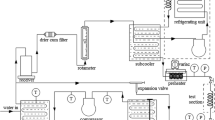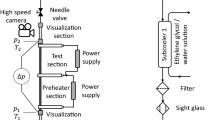Abstract
This research represents an experimental investigation of the metastable flow and re-condensation phenomenon through non-adiabatic lateral helical capillary tubes and suction tube heat exchanger. The results show that mass flux ratio has a vital role: It affects metastable flow and also reverse heat transfer phenomenon through non-adiabatic helical capillary tube. Therefore, by increasing of the mass flux ratio, the rate of heat transfer between them decreases. In contrast to the strong rate condition of heat transfer between them, reverse heat transfer or re-condensation maybe happen. Moreover, experimental results show that for R134 flow with mass flux ratio more than 57.84, metastable flow exists in non-adiabatic capillary tube with 0.9144 mm inner diameter, 30 mm coil diameter, 6.18 m length, 4 mm inner diameter of compressor suction tube.
Similar content being viewed by others
References
G. Zhou and Y. Zhang, Numerical and experimental investigations on the performance of coiled adiabatic capillary tubes, App. Therm. Eng., 26 (2006) 1106–1114.
G. Zhou, Y. Zhang, Y. Yang and X. Wang, Numerical model for matching of coiled adiabatic capillary tube in a split air conditioner using HCFC22 and HC290, App. Therm. Eng., 30 (2010) 1477–1487.
G. Zhou and Y. Zhang, Inlet pressure fluctuation characteristics of coiled adiabatic capillary tubes, App. Therm. Eng., 33-34 (2012) 183–189.
M. Zareh, H. Shokouhmand, M. R. Salimpour and M. Taeibi, Numerical simulation and experimental analysis of refrigerants flow through adiabatic helical capillary tube, Int. J. Refrigeration, 38 (2014) 299–309.
M. Zareh, P. Javidmand and K. A. Hoffmann, An experimental comparison of the refrigerant flow along adiabatic and diabatic coiled capillary tubes, 15th International Refrigeration and Air Conditioning Conference at Purdue, July 14-17 (2014).
H. Shokouhmand and M. Zareh, Experimental investigation and numerical simulation of choked refrigerant flow through helical adiabatic capillary tube, App Therm. Eng., 63 (2014) 119–128.
M. Zareh and M. Ghorbani Heidari, The metastable flow through adiabatic and diabatic coiled capillary tubes, 12th International Conference of Numerical Analysis and Applied Mathematics, 22-28 Sep., Greece (2014).
Y. Liu and C. W. Bullard, An experimental and theoretical analysis of capillary tube-suction line heat exchangers, Thesis, Air Conditioning and Refrigeration Center, Mech. & Indu. Eng. Dept. Univ. of Illinois (1997).
N. Ablanque, C. Oliet, J. Rigola and C. D. P. Segarra, Numerical model of capillary tubes: enhanced performance and study of non-adiabatic effects, 15th International Refrigeration and Air Conditioning Conference, Purdue, July (2014) 14–17.
D. Sarker and J. H. Jeong, Development of empirical correlations for non-adiabatic capillary tube based on mechanistic model, International J. of Refrigeration, 35 (2012) 974–983.
P. K. Bansal and C. Yang, Reverse heat transfer and recondensation phenomena in non-adiabatic capillary tubes, App. Therm. Eng., 25 (2005) 3187–3202.
O. García-Valladares, Numerical simulation of nonadiabatic capillary tubes considering metastable region, Part I: Mathematical formulation and numerical model, International J. of Refrigeration, 30 (2007) 642–653.
O. García-Valladares, Numerical simulation of nonadiabatic capillary tubes considering metastable region, Part II, International J. of Refrigeration, 30 (2007) 654–663.
M. K. Khan, R. Kumar and P. K. Sahoo, Flow characteristics of refrigerants flowing through capillary tubes-A Review, App. Therm. Eng., 29 (2009) 1426–1439.
D. Chen and S. Lin, Underpressure of vaporization of refrigerant R-134a through a diabatic capillary tube, Int. J. Refrigeration, 24 (2001) 261–271.
A. A. S. Huerta, F. A. S. Fiorelli and O. M. Silvares, Metastable flow in capillary tubes: an experimental evaluation, Exp. Therm. Fluid Sci., 31 (2007) 957–966.
C. Melo, R. T. S. Ferreira, C. Boabaid Neto, J. M. Gonçalves and M. M. Mezavila, An experimental analysis of adiabatic capillary tubes, App. Therm. Eng., 19 (1999) 669–684.
F. A. S. Fiorelli, C. A. S. Silva and A. A. S. Huerta, Metastable flow of R-410A in capillary tubes, App. Therm. Eng., 51 (2013) 1181–1190.
O. Garcia-Valladares, C. D. Pérez-Segarra and A. Oliva, Numerical simulation of capillary tubes expansion devices behavior with pure and mixed refrigerants considering metastable region, Part I: Mathematical formulation and numerical model, App. Therm. Eng., 22 (2002) 173–182.
O. Garcia-Valladares, C. D. Perez-Segarra and A. Oliva, Numerical simulation of capillary tubes expansion devices behavior with pure and mixed refrigerants considering metastable region, Part II: experimental validation and parametric studies, App. Therm. Eng., 22 (2002) 379–391.
C. J. L. Hermes, C. Melo and J. Gonçalves, M Modeling of non-adiabatic capillary tube flows: A simplified approach and comprehensive experimental validation, International J. of Refrigeration, 31 (2008) 1358–1367.
J. Sinpiboon and S. Wongwises, Numerical investigation of refrigerant flow through non-adiabatic capillary tubes, App. Therm. Eng., 22 (2002) 2015–2032.
B. Xu and P. K. Bansal, Non-adiabatic capillary tube flow: a homogeneous model and process description, App. Therm. Eng., 22 (2002) 1801–1819.
Y. Islamoglu, A. Kurt and C. Parmaksizoglu, Performance prediction for non-adiabatic capillary tube suction line heat exchanger: an artificial neural network approach, Energy Conversion and Management, 32 (2008) 233–243.
M. Zareh, M. Heidari and P. Javidman, Numerical simulation and experimental comparison of the R12, R22 and R134a flow inside straight and coiled helical capillary tubes, JMST, 30 (2016) 1421–1430.
J. Kim, J. Lee, C. Choi, S. Lee, S. Oh and W. Park, Experimental study of R134a/R410A cascade cycle for variable refrigerant flow heat pump systems, JMST, 29 (2015) 5447–5458.
V. Padmanabhan and S. K. Palanisamy, Exergy efficiency and irreversibility comparison of R22, R134a, R290 and R407C to replace R22 in an air conditioning system, JMST, 27 (2013) 917–926.
Author information
Authors and Affiliations
Corresponding author
Additional information
Recommended by Associate Editor Chang Yong Park
Masoud Zareh is Assistant Professor of Mechanical and Aerospace Engineering Department, Science Research Branch, Islamic Azad University. He received his Ph.D. in mechanical engineering, energy conversion. His research interests include Experimental & Numerical Modeling of the Multi-phase flow, Two- Phase Flow and Heat Transfer, Pulsating &Oscillating Heat Pipes, Computational Fluid Dynamics (CFD), Modeling and Simulation of Transport phenomena in porous media, Experimental and Numerical Simulation of Cooling Tower, specially the Optimization of the HVAC System and also Renewable Energy (Postdoctoral Researcher in University of Manitoba).
Rights and permissions
About this article
Cite this article
Zareh, M., Heidari, M.G. Experimental investigation of the reverse heat transfer of R134a flow through non-adiabatic coiled capillary tubes. J Mech Sci Technol 30, 3339–3346 (2016). https://doi.org/10.1007/s12206-016-0643-2
Received:
Revised:
Accepted:
Published:
Issue Date:
DOI: https://doi.org/10.1007/s12206-016-0643-2




